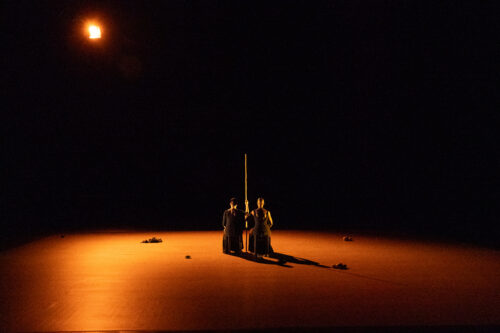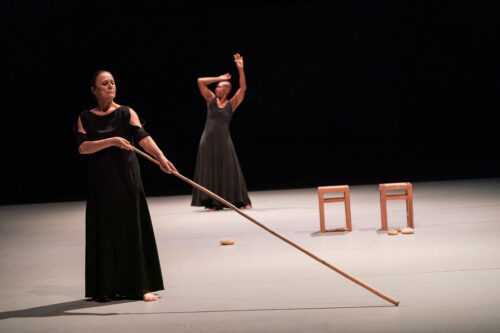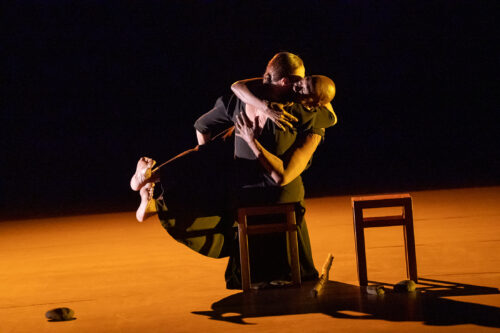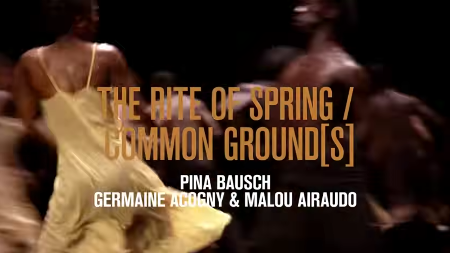RITE ON!
As part of an international tour, the weekend-long dance program that opened at the Dorothy Chandler Pavilion on Thursday — an extra-added night due to ticket demand — gave us a taste of the neo-expressionist work of trailblazer Pina Bausch, whose company The Tanztheater Wuppertal Pina Bausch made its American debut here in Los Angeles as the opening performance of the 1984 Olympic Arts Festival. The double bill opened with a tribute to Bausch — who passed in 2009 at 68 — the L.A. premiere of common ground[s], co-choreographed and performed by two matriarchs of dance, Germaine Acogny and Malou Airaudo. Ms. Acogny is known as the mother of contemporary African dance, and Ms. Airaudo is a founding member and icon of Tanztheater Wuppertal. The second half, The Rite of Spring, an iconic 1975 work, features Bausch’s monumental choreography and 30 dancers from 13 African countries, who rehearsed the work at École des Sables in Senegal (co-founded by Acogny and Airaudo). It is spectacular and rightfully one of her most famous works. Together, the pieces will show you how Bausch has both mesmerized and repelled audiences throughout the world.
Germaine Acogny and Malou Airaudo in common ground(s)
common ground[s] incorporates Pina Bausch hallmarks — a nonlinear narrative vignette set in an unusual stage environment of extravagant size and texture; curious props; ironic twists; self-revelatory text (one speaks in French, the other responds in barely audible English); repetition of simple movements or phrases; seemingly random imagery; and exploring the dichotomies inherent in relationships between individuals (or group for Rite of Spring) — whether brutal or benign. While our dancemakers successfully added all of these elements, it is definitely a taste of Pina Bausch that is definitely not for all tastes.
 Germaine Acogny and Malou Airaudo in common ground(s)
Germaine Acogny and Malou Airaudo in common ground(s)My companion found it to be a 30-minute slog, but I was intrigued. Fascinatingly enough, the piece began in utter darkness and silence. Audience members, quiet at first, started to get restless: one whooped, others tittered, and there was the kind of coughing and rustling usually reserved for the silence between movements of a symphony. After quite some time, patrons settled in, and for a few magnificent seconds, became one. I took it for a sign of what was to come: A meditative piece that needs to wash over you like the music of Philip Glass.
 Germaine Acogny and Malou Airaudo in common ground(s)
Germaine Acogny and Malou Airaudo in common ground(s)After the blackness, as if prior to dawn, a slow orange light rises on two women, seated side by side with their backs to the audience, they greet the new day by turning to each other with a warm, caring embrace. Across the white Marley floor are little piles of smooth stones, two wooden backless chairs, and a few tall wooden walking sticks. The stage at the Dorothy Chandler Pavilion became an impressive vastness. Very familiar to the world of dance, the musical composition by Fabrice Bouillon LaForest begins with a single sustained note, his score using everything from vibrant musical instrumentation to silence to chirping crickets, collaborating with sound designer Mark Grey.
 Germaine Acogny and Malou Airaudo in common ground(s)
Germaine Acogny and Malou Airaudo in common ground(s)Whichever relationship you may project onto this couple, it’s a cherished one to say the least. Zeynep Kepekli’s lighting shines down onto the two women, both of whom are in their mid-to-late 70s, and, as the sunlight moves throughout the day, they spend their time in movement, caring for one another, supporting, assisting, conversing, singing, and massaging; after separating for moments of alienation, they return with the warmest of support and kindness. By the end of the day, as we’re left in a dimming blue light of night, they exit hand in hand. Depending on the viewer, it’s a meaningful, lovely way to spend a day or a head-scratcher.
Pina Bausch's The Rite of Spring
A 30-minute intermission is needed for the hard-working backstage crew of 14 who prepare the space for the second piece, The Rite of Spring. Rolf Borzik’s set design replaces the Marley floor with several dumpsters of peat moss which are poured over the large, squared stage. Get to your seats early — the filling and raking are most watchable.
Pina Bausch's The Rite of Spring
It’s thrilling to witness such an exhaustive, ritual work as The Rite of Spring. The 35-minute piece uses the powerful ballet score Le Sacre du printemps by Igor Stravinsky, originally written in 1913 for Sergei Diaghilev’s Ballets Russes company. The score’s dissonance and irregular stresses and rhythms (which, along the avant-garde nature of Diaghilev’s choreography was enough to cause a near riot at its premiere) still shock, given how startlingly original the music is and, even more, how it has stood the test of time since it thrust classical music into the modern era. With its dynamic, lush score, it matches Bausch’s intense, rigorous choreography — one of the most athletic, vigorous ballets you will ever witness.
Pina Bausch's The Rite of Spring
The opening image is that of a woman lying upon a red fabric, which later is balled up and passed among the female ensemble, and lastly worn as a red slip by the chosen human sacrifice. From the dozen women in beige slips and the 18 bare-chested men in black pants (costumes by Borzik), the movement prevails over a nervous anxiety of confrontation. Because there is no delineated backstage space, the dancers run in from the extreme side entrances to the theater with a raw, intense energy. The men mix with the women, lifting them, encircling them, and breaking off into numerous ritualistic patterns of lines, triangles, and circles, ultimately choosing the one to be sacrificed. Dripping from sweat, covered in dirt, and panting for breath, this is a ballet of intense ferocity and chaos that the dancers (and the audience) may never get to experience again in a lifetime.
Pina Bausch's The Rite of Spring
Bausch’s direction has not often been performed by artists unaffiliated with her company, which may explain the five rehearsal directors –Çağdaş Ermiş, Ditta Miranda Jasjfi, Barbara Kaufmann, Julie Shanahan, and Kenji Takagi — and three Restaging Artistic Directors Jo Ann Endicott, Jorge Puerta Armenta, and Clémentine Deluy.
The dancers are Kouassi Rodolphe Allui, Sahadatou Ami Toure, Dovi Afi Anique Ayiboe, Korotimi Barro, Evrard Elisee Bekoin, Ugwarelojo Gloria Biachi, Luciene Cabral, Khadija Cisse, Sonia Zandile Constable, Rokhaya Coulibaly, Inas Dasylva, Joannie Diane, Astou Diop, L. Serge A. Dodo, Christie Dossou, Adjo Delali Foli, Aoufice Junior Gouri, Zadi Landry Kipre, Bazoumana Kouyate, Profit Lucky, Babacar Mané, Vuyo Mahashe, Vasco Pedro Mirine, Stéphanie Mwamba, Sidnoma Florent Nikiema, Shell Tetely Ohene-Nyako, Brian Oloo, Harivola Rakotondrasoa, Oliva Randrianasolo, Asanda Saru Ruda, Tom Jules Samie, Amy Collé Seck, Pacome Landry Seka, Gueassa Eva Sibi, Carmelita Youriane G. Siwa, Armel Gnago Sosso-Ny, Amadou Lamine Sow, Kadidja Tiemanta, and B Abdoul Aziz Zoundi.
Pina Bausch's The Rite of Spring
photos taken at New York’s Park Avenue Armory by Stephanie Berger
common ground[s] / The Rite of Spring
Tanztheater Wuppertal Pina Bausch
a Pina Bausch Foundation, École des Sables and Sadler’s Wells production
presented by Glorya Kaufman Presents Dance at The Music Center
Dorothy Chandler Pavilion in DTLA
ends on February 11, 2024
for tickets, call 213.972.0711 or visit Music Center
tour continues; for dates and cities, visit Pina Bausch Foundation


{ 2 comments… read them below or add one }
While I admire the women in the common ground(s) piece for their contribution to dance I found the piece to be only mildly involving. Rite of Spring on the other hand was one of the most if not the most riveting dance experiences I have had. Absolutely amazing.
I had the immense pleasure of witnessing The Rite of Spring in Charleston SC. Words cannot express how inspiring and refreshing this piece was!!!!!!! I was involved the entire performance! Awesome, riveting, tremendous, inspiring, exciting, transformative – there aren’t enough words to describe how I felt watching this dance. I haven’t sat on the edge of my seat in a long time, but I was mesmerized by the dancers LEAVING IT ALL ON THE FLOOR. Although I did not see the need for the peat, every twist, turn, leap, and physical connection was worth the wait. I could watch it repeatedly and never get tired.
The other piece did leave me scratching my head. As an older dancer myself, I understand physical limitations, however, for me and the person sitting beside me it was just boring.